Stewart Penney/LONDON

Transport and support aircraft attract fewer headlines than their fighter and bomber brethren, but they play a vital part in the make-up of every air arm worldwide.
Recent events over the former Republic of Yugoslavia underline the need for such aircraft. Transports to deliver the necessary men and material, surveillance aircraft to provide commanders with up-to-date intelligence on their foe's movements, maritime patrol aircraft to watch for sanction busters and tankers to give combat aircraft the fuel to carry warloads.
Some notable competitions have been settled in the past 12 months, including the Australian Wedgetail and Greek AEW&C competitions, and the UK Airborne Stand-off Radar competition. AEW battles continue in Turkey - which is widely expected to follow Australia's lead - and South Korea. NATO, meanwhile, continues to avoid making an air-to-ground surveillance choice.
Tactical transport competitions are under way in Australia and Greece, both of which are looking at the derivatives of successful types: the Casa C295 stretch of the older CN235 as well as the Lockheed Martin Alenia Tactical Transport Systems re-engined and re-equipped G222, the C-27J. Taiwan has evaluated these to replace Fairchild C-119s retired in 1997.
Seven European NATO nations are looking at future large transports. Belgium, France, Germany, Italy, Spain, Turkey and the UK are all considering the Airbus A400M, while the Antonov An-7X (a Westernised An-70), Boeing C-17 and Lockheed Martin C-130J are also competitors. The UK also needs an airlifter to fulfil the Short Term Strategic Airlifter requirement outlined in the 1998 Strategic Defence Review for "C-17 or similar" aircraft. Antonov An-124s and the Airbus Beluga are also in the running.
Brazil has been given approval to procure ex-US Navy Lockheed Martin P-3 Orions, sating a need which has existed for several years. The Philippines initiated a competition for similar aircraft in 1997, but its poor finances appear to have shelved the requirement.
As well as traditional manufacturers of military aircraft, air forces continue to be a lucrative market for airliner and business jet manufacturers, with the big hitters in both sectors continuing to find military uses for their products.
Airbus and Boeing are offering their airliners as tanker/transports and as platforms for high-flying AEW radar.
Bombardier, Gulfstream and other business jet manufacturers sell their products as VIP/communications types and as special missions platforms with sensors for surveillance, intelligence gathering and long-range search and rescue.
Abbreviations
AEW airborne early warning; AEW&C airborne early warning and control; ASW anti-submarine warfare; ATM air traffic management; AWACS airborne warning and control system; BAe British Aerospace; CNS communications, navigation, surveillance; COMINT communications intelligence; Dasa DaimlerChrysler Aerospace; DoD US Department of Defense; ESM electronic support measures; ELINT electronic intelligence; FLA Future Large Aircraft; FLIR forward looking infrared; GE General Electric; GPS global positioning system; IAI Israel Aircraft Industries; INS inertial navigation system; ISAR inverse synthetic aperture radar; JASDF Japan Air Self-Defence Force; JMSDF Japan Maritime Self-Defence Force; medevac medical evacuation; MTI moving target indicator; P&W Pratt & Whitney; RAF UK Royal Air Force; R-R Rolls-Royce; SAR synthetic aperture radar; satcom satellite communications; SIGINT signals intelligence; STOL short take-off and landing; TV television; USAF US Air Force; USMC US Marine Corps; USN US Navy.
Conversion factors
1hp/shp=0.745kW 1nm=1.85km 1ft=0.3m 1kN=22lb 1kt=1.85km/h
AEROMOT Aeronaves E Motores SA, Av Das Industrias 1210, Porto Alegre 90200-290, Brazil; tel: +55 (51) 371 1644; fax: +55 (51) 371 1655
AMT-100/200/300
Brazil's Aeromot has developed a military observation variant of its licence-produced, French-designed, Fournier RF-10 motor glider. A total of 100 Limbach L200-powered AMT-100Ps and AMT-100Rs has been ordered by Brazil for military and paramilitary operators. The aircraft can be fitted with a fuselage-mounted pod for the carriage of surveillance equipment and has additional windows to aid ground surveillance. The AMT-200 is powered by a normally aspirated Rotax engine, while the AMT-300 uses a turbocharged unit.
AEROPROGRESS Aeroprogress, Novozavodskaja st 18, Div 20, Moscow 121309, Russia; tel: +7 (95) 145 8044; fax: +7 (95) 145 9477
Russia's Aeroprogress offers a military variant of its T-101 Gratch single turboprop utility aircraft, which was designed as a monoplane replacement for the 1940s' vintage Antonov An-2 Colt biplane. The military-specificationT-101S differs from the civilian version in having winglets, four underwing stores points, and stub wings, each with a weapon and tip stores position. A Westernised T-101, the T-201, has also been offered.
For most of the past decade, Aeroprogress and its associated ROKS-Aero design bureau have also been proposing other utility and military designs, such as the T-501 Strizh turboprop trainer and T-701 twin-turboprop counter-insurgency aircraft. In the light of Russia's financial difficulties, all appear to remain paper studies, with little hope of further progress.
AIRBUS Airbus Industrie, 1 Rond Point Maurice Bellonte, Blagnac, 31707 Cedex, France; tel: +33 (5) 61 93 30 19; fax: +33 (5) 61 93 34 70; web: www.airbus.com
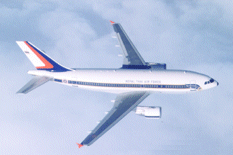
Separately from its military company, Airbus markets variants of its A300, A300-600 and A310 twin-engined widebody airliners for the tanker/transport role. Ex-airline aircraft are also in service with the Belgian, Canadian, French, German and Thai air forces.
In addition, Raytheon has offered the A310 as a platform for Israel Aircraft Industries' Phalcon AEW radar system in Australia and it remains in contention in Turkey. As an AEW platform, the A310 would be equipped with a non-rotating dome above the rear fuselage.
Airbus has an exclusive agreement with Raytheon, which will provide refuelling systems, to market Airbus Multirole Tanker/ Transports (MRTTs) worldwide, including for the UK's Future Strategic Tanker Aircraft (FSTA)requirement .
Typical MRTT configuration includes wing-mounted hose units, as well as a rear underfuselage position with a further hose unit and/or flying boom. Fuel would be carried in the A300/A310's normal tanks and in additional underfloor tanks. The main deck is fitted with a large cargo door.
Lockheed Martin and Airbus partner Aerospatiale Matra have also agreed to market tanker/transports based on Airbus platforms. As well as competitions such as the FSTA, the pair also view the Airbus A340 as a potential replacement for the USAF's massive KC-135 fleet.
AIRBUS MILITARY COMPANY Airbus Military Company, 17 Avenue Didier Daurat, Blagnac, 31707 Cedex, France; tel: +33 (5) 61 93 30 51; fax: +33 (5) 62 11 06 11; web: www.airbus.com
A400M
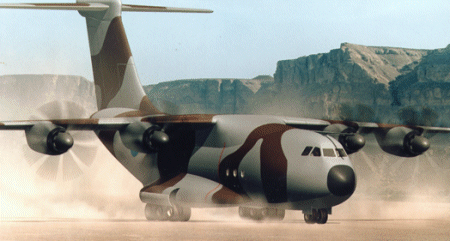
Airbus Military Company (AMC) responded to the seven-nation European Staff Requirement for a Future Transport Aircraft in January, marking another milestone in the design of the A400M (formerly the Future Large Aircraft). The A400M is being offered as a replacement for Lockheed Martin C-130 Hercules and Transall C-160 transports in Belgium, France, Germany, Italy, Spain, Turkey and the UK, which, between them, have specified a need for 288 aircraft. AMC suggests a unit price of $80 million, based on this number.
Components will be built by companies from all seven countries - including the Airbus partners Aerospatiale Matra, British Aerospace, Casa and Dasa - along with Alenia, FLABEL and Turkish Aerospace Industries. Casa's Seville plant was selected as the final assembly location in March.
The programme continues to face funding and political barriers, not least the German Government's continuing interest in a Westernised version of the Antonov An-70, the An-7X. Other types being considered in some or all of the seven countries include the C-130J and the Boeing C-17. Funding is also a major issue, with AMC believing government money is the best means of financing the $6 billion development costs.
A competition to supply a 7,100kW turboprop remains unresolved, with two contenders: BMW Rolls-Royce offering a BR710 derivative; and a Snecma/MTU/ITP/Fiat team offering the M138, based on the core of the Dassault Rafale's M88. Dowty and Raiter-Faigec are competing to supply the propeller.
The A400M will be four-engined, with a high wing, T-tail and rear loading ramp. A tanker version will have two wing-mounted hose units, as well as a flying boom and/or a third fuselage-mounted hose unit.
ALENIA Alenia Aerospazio, Via Giulio V Bona 85, Rome I-00156, Italy; tel: +39 (6) 417 231; fax: +39 (6) 411 4439; telex: 611395 Alenia I
G222/C-27 Spartan
The twin turboprop G222 remains in service around the world, production having ended in early 1989. In conjunction with Lockheed Martin, Alenia is developing an upgraded version, the C-27J (see Lockheed Martin Alenia Tactical Transport Systems). The Italian air force continues to consider upgrades. ANTONOV Antonov Aeronautical Scientific and Technical Complex, 1 Tupolev str, Kiev 252062, Ukraine; tel: +380 (44) 442 57098; fax: +380 (44) 449 59996; telex: 131048,132792 OZON
An-32 Cline
Antonov continues to market the An-32 twin turboprop transport and sold four to Venezuela in mid-1999. The aircraft is a "hot-and-high" development - with almost twice the installed power - of the An-26, production of which has ceased. Antonov has also developed variants for paramilitary tasks such as fisheries protection and firefighting.
An-70/An-7x
Developed as a replacement for the An-12, the An-70 first flew in December 1994, but the first prototype of the four-propfan transport was lost in a fatal accident in February 1995. The second prototype An-70 flew in April 1997. Antonov used the static-test airframe as the basis for the second prototype.
The German Government continues to perceive the An-70 as a potential Future Transport Aircraft. A Dasa study concluded early this year that the aircraft would meet the European Staff Requirement, but a new cockpit and avionics would be needed and engine systems would have to be improved.
Two consortia have been formed around the aircraft. The Russian and Ukrainian firms participating in the An-70 programme have formed a grouping called Medium Transport Aircraft, which is linking with German consortium Airtruck.
Designed to fulfil a Russian air force requirement, the An-70 has been test flown by the Russians, yet a major production order appears to be some way away as the cash-strapped air force struggles to fulfil its needs.
An-72/74
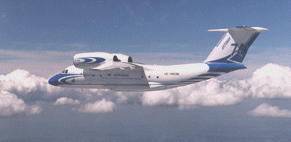
The An-72/74 was designed as a STOL transport, principally for use in Russia's frozen tundra, but it has been developed for other roles, including maritime reconnaissance (An-72P), stand-off reconnaissance (An-72R) and an AEW version (An-71), with a fin-top-mounted radar scanner.
STOL performance is achieved by flowing the exhaust from the twin Lotarev D-36 turbofans across the upper surface of the wing and flaps. Unlike most transports designed for the former Soviet air forces, the An-72/74 has a three flightcrew rather than the usual six.
An-124 Ruslan
Interest in Antonov's behemoth has increased in the past 12 months, with the An-124 being offered by two teams to meet UK's Short Term Strategic Airlifter requirement. One, led by Air Foyle - a commercial operator of the type - is offering An-124s re-engined with R-R RB211-524HT turbofans and with extensive avionics and systems changes that will halve the crewing requirement to three.
Unless selected, however, the project will remain a paper study. Meanwhile, IBP is offering unmodified An-124s, with standard D-18Tturbofans and six-man cockpits.
Designed as a Soviet equivalent to the Lockheed C-5 Galaxy, the An-124 can be loaded simultaneously at the nose and tail. The cargo hold is 36m long, 6.4m wide and 4.4m high, while a pressurised upper deck can accommodate 88 passengers.
ATR Avions de Transport Regional, 1 Allée Pierre-Nadot, Blagnac, F3172 France; tel: +33 (5) 6221 6221; fax: +33 (5) 6221 6720; telex 533 984 F/GIE ATR; web: www.airegional.com
ATR 42/72
ATR continues to offer military derivatives of its ATR 42 and ATR 72 twin turboprop regional airliners. The first of five ATR 42MPs for the Italian customs service was displayed by Alenia Difesa, the defence arm of ATR's Italian partner, at the 1999 Paris air show. The aircraft is equipped with underfuselage radar, gun pod, television, a turret mounted FLIR in the starboard undercarriage sponson and two mission stations in the cabin. Similar modifications are offered on the larger ATR 72, although no customer has been signed.
A military variant of the ATR 72, the ATR 52C is on offer to meet intra-theatre transport requirements. This uses the ATR 72-100 airframe, but has a rear ramp-type cargo door and a strengthened cabin floor. A launch customer has yet to be secured. BERIEV Beriev, 1 Aviatorov Square, Taganrog 347928, Russia; tel: +7 (863) 44 49 839; fax: +7 (863) 44 41 454; telex: BETA SU
A-40 Albatros
Two prototypes of the A-40 maritime-patrol amphibian have been flown, but the programme is moribund, with no funding from Russia's naval aviation forces. The twin turbofan A-40 was designed to replace the Ilyushin Il-38 May and Beriev Be-12 Mail. The aircraft is optimised for long-range ASW, with a nose-mounted refuelling probe above a large radome and provision for a retractable magnetic-anomaly detector.
Engines are mounted on booms extending from the fuselage and wing trailing edge, well above the wing, to prevent water ingestion during take-off and landing. An SAR-optimised version, the Be-42, has also been proposed. The type would have nine crew and room for up to 54 survivors.
A commercial version, the Be-200, made its first flight last September.
A-50
Beriev's A-50 Mainstay is an AEW aircraft based on the Ilyushin Il-76 airframe. First developed during the 1980s, Beriev has outlined upgrades based on an improved radar system with MTI capability, and a passive detection system. Beriev is also working on a version of the A-50 for the Chinese air force, using the Israeli Elta Phalcon radar in a non-rotating dome.
A single aircraft could be delivered for validation purposes by the end of this year. The four Chinese A-50s will also be equipped with electronic surveillance, electronic intelligence and communications intelligence systems similar to those installed in the IAI Elta Phalcon-equipped Boeing 707 sold to Chile. BOEING Boeing, PO Box 3999, Seattle, Washington 98124-2499, USA; tel: +1 (206) 657 1380; fax: +1 (206) 773 3900; web: www.boeing.com
737
In 1997, a quick-change version of Boeing's 737-700 was selected as the US Navy Unique Fleet Essential Airlift Replacement Aircraft. The first C-40A will be delivered in December 2000, when it will start to replace ageing McDonnell Douglas C-9 transports. Three aircraft, with increased gross weights and forward cargo-doors, will be delivered against a requirement for up to 27.
The 737-700-derived Boeing Business Jet has been selected by Australia, and is being offered to Turkey, as the platform for an AEW&C aircraft. A Northrop Grumman Multirole Electronically Scanned-Array (MESA) radar is mounted over the rear fuselage in an oblong stationary antenna.
Earlier 737 versions are in service with the USAF as the T-43 navigation trainer, and with Indonesia as the maritime-patrol 737 Surveiller, which is equipped with a dorsal-mounted Motorola side-looking radar. All three generations of the 737 have proved popular with air forces worldwide in the VIP role.
747
A Boeing-led team was awarded a $1.1 billion US Air Force contract in November 1996 to develop the Airborne Laser (ABL), a modified 747-400F carrying a high-energy laser designed to shoot down theatre ballistic missiles in the boost phase, at ranges of up to 600km. One YAL-1A prototype will be flight-tested in 2001-2 and plans call for seven to be operational by 2008. The ABL 747 will be equipped with a 2.64m-diameter nose turret housing the beam-steering optics for the TRW-developed chemical oxygen-iodine laser.
The 747 is in USAF service as the VC-25A Presidential transport (two 747-200s) and the E-4B airborne command post (four 747-200s). The Japan ASDF operates two 747-400s as VIP transports.
757
The USAF has taken delivery of four 757-200s ordered in 1997 as part of the VC-X programme to replace 707-based C-137 VIP transports. Delivery of the aircraft, designated the C-32A, began in mid-1998. Boeing operates a 757 as an avionics flying testbed for the Lockheed Martin/Boeing F-22. The aircraft is fitted with an F-22 nose for testing of the Northrop Grumman APG-77 active array radar, and has a "sensor wing" for flight tests of the complete avionics.
767
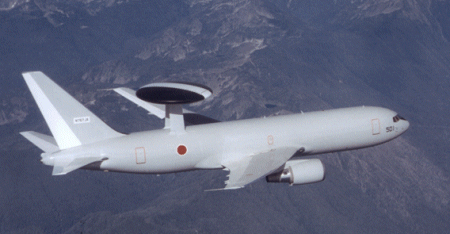
The Japan ASDF has taken delivery of four E-767 AWACS aircraft and Boeing continues to market the 767-based AWACS. Based on the 767-200ER, the aircraft is equipped with the upgraded mission system developed for the E-3 Sentry, including the Northrop Grumman APY-2 radar with rotodome-mounted antenna. Time on station is 10h at 550km radius, and the aircraft can carry a mission crew of 18.
Boeing is offering other military derivatives of the 767, including a tanker/transport variant proposed to the UK as its Future Strategic Tanker Aircraft. Israel's Elta has also proposed the 767 as a platform for its Phalcon phased-array AEW radar.
C-17 Globemaster III
As production of an additional 80 C-17s continues for the USAF, the DoD has requested funding for another 14 Globemasters in FY2004/5 for special operations missions. Boeing has made an unsolicited bid to the USAF for an additional 60 aircraft at $149 million each - about $50 million cheaper than those supplied in the current batch.
The UK is considering the type for its Short Term Strategic Airlifter requirement, for four C-17-class aircraft. If successful, the UK will become the aircraft's first export customer. In the longer term, the UK is also considering the C-17 to meet, at least in part, the Future Transport Aircraft requirement.
Boeing has embarked on a product development programme for the C-17 that includes the additional plumbing and other systems to allow an extra 37,900litre of fuel to be carried in the centre wing box. The so-called Extend Range Tank would boost range with a 40,700kg payload from 6,850km to 8,000km.
Designed to replace the Lockheed C-141, the C-17 was first flown in September 1991. It is powered by four 40,700lb-thrust P&W F117 turbofans (military PW2000s). Several C-17 derivatives have been studied, including a tanker/transport version and stretches of the basic airframe.
E-3 Sentry
Although production of the E-3 has concluded following the closure of the 707 line, the type continues to receive upgrades, including improvements to the Northrop Grumman APY-1 and -2 under the Radar System Improvement Programme, which enhances capability against low cross-section targets. Other upgrades involve the mission computer, operator consoles, and communications, navigation and identification systems.
Under the Extend Sentry programme, Boeing is studying retrofitting E-3s with the Next Generation 737 flightdeck, complete with flat-panel displays. Testing has started of the Eagle infrared search-and-track sensor and laser rangefinder, to give the Sentry the ability to detect and track theatre ballistic-missiles.
USAF and NATO aircraft are powered by P&W TF33s, while later ones for France, Saudi Arabia and the UK have CFM56s.
E-6 Mercury
Raytheon Systems delivered the first E-6B to the USN in May 1997. The E-6B combines the TACAMO submarine-communications mission of the original E-6A with the Looking Glass airborne command-post role performed by USAF Boeing EC-135s.
Options have been placed to convert four additional aircraft to E-6Bs. Boeing has proposed upgrading the E-6 with the Next Generation 737 flightdeck.
Based on the 707 airframe, and powered by four CFM International CFM56 turbofans, the E-6 was first flown in June 1987, and 16 were delivered to the USN.
KC-10 Extender
The USAF took delivery of 60 KC-10 tanker/transports based on the DC-10 airframe. Since service entry, the aircraft have been updated with wing-mounted hose units to allow the KC-10 to refuel USN and Allied aircraft fitted with in-flight refuelling probes rather than flying boom receptacles typical of USAF aircraft. The Royal Netherlands Air Force took delivery of two ex-Martinair DC-10-30CFs converted by McDonnell Douglas and KLM to the broadly similar KDC-10 standard.
KC-135 Stratotanker
The USAF continues to re-engine KC-135s with CFM56s and is putting the aircraft through the Pacer Crag programme to update cockpit avionics and systems. It is seeking a commercial off-the-shelf solution to ensure the type is compatible with future air traffic management environments.
The upgrade will include an Inmarsat satellite communications link, a VHF datalink and the addition of a second GPS/INS to replace the outdated INS.
BOMBARDIER Bombardier Aerospace, PO Box 6087, Station Centre-ville, Montreal, Quebec H3C 3G9, Canada; tel: +1 (514) 855 5000; fax: +1 (514) 855 7903; web: www.bombardier.com
Canadair Challenger
Canada operates 17 Challenger 600 business jets, as CC-144/CE-144As, on missions including transport, flight inspection, air ambulance, electronic-warfare training and coastal patrol. The German air force also operates seven aircraft in the VIP/communications role.
Canadair CL-415
Bombardier has proposed the CL-415M as a special-mission variant of the twin turboprop amphibious aircraft. Deliveries of this upgraded version of the CL-215 piston-powered amphibian, for firefighting missions, began in November 1994.
de Havilland Dash 8
A maritime-patrol derivative of the Dash 8-300 twin turboprop regional aircraft is being proposed by Bombardier. Military Dash 8M-100s are in service with the Canadian Forces (two CC-142 transports and four CT-142 navigation trainers) and the USAF (two range-control E-9As).
Global Express
Bombardier secured its first military customer for the Global Express long-rang business jet when Raytheon Systems was selected as the preferred bidder for the UK's Airborne Stand Off Radar programme. Raytheon plans to mount its combined SAR/MTI ground surveillance radar on five Global Express aircraft. The first aircraft will be delivered to Raytheon for conversion in 2002, with service entry scheduled three years later.
Learjet 35A/36A

Military variants of the Learjet 35A/36A business jet include 84 35As operated by the USAF as C-21A transports and five 36As operated by the Japan MSDF as utility U-36As. Several air forces operate the twin-turbofan aircraft for target towing.
BRITISH AEROSPACE British Aerospace Military Aircraft & Aerostructures, Lancaster House, Farnborough Aerospace Centre, Farnborough, GU14 6YU Hants, UK; tel: +44 (1252) 373 232; fax: +44 (1252) 384 812
Nimrod MRA4

BAe won the UK's Replacement Maritime Patrol Aircraft competition in 1996 with a bid based on a refurbished Nimrod MR2. The Nimrod 2000 programme will see 21 aircraft re-engined with four BMW R-R BR710 turbofans and equipped with a Boeing mission system. As well as systems updates, airframes are being refurbished and given an extended service life, new wing and pressure floor.
The £2.4 billion ($3.8 billion) programme has run into problems, however, and it was announced in March that delays have pushed back the aircraft's in-service date from 2003 until at least 2005. The RAF also operates three Nimrod R1s in the electronic-intelligence role.
BRITTEN-NORMAN Britten-Norman, Bembridge Airport, Bembridge, PO35 5PR, Isle of Wright, UK; tel: +44 (1983) 872511/5; fax+44 (1983) 873246; telex: 86277/86866; web: www.britten-norman.com
Defender
Britten-Norman, having been sold by its Pilatus parent company, continues to offer the Defender and Turbine Defender for diverse utility roles. Operators of the turbine-engined Defender include the British Army, Cyprus Police, Moroccan Ministry of Fisheries and the Pakistan Maritime Security Agency.
The piston-engined variant is in operation with the Belgian army, Belize defence force and the Indian and Philippine navies, among other customers. All variants can be fitted with a variety of surveillance equipment for off shore patrol or light maritime attack.
CASA Construcciones Aeronauticas SA, Avenida de Aragon 404, PO Box 193, Madrid 28022, Spain; tel: +34 (91) 585 70 00; fax: +34 (91) 585 7666; telex: 41696/41726
C212 Aviocar
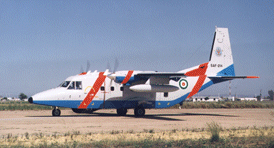
CASA has started deliveries of the C212-400, including two, one in maritime patrol configuration and one transport, to the Surinam air force. The C212-400 differs from earlier versions in having an uprated engine, electronic flight instrument system, and avionics moved into the nose baggage compartment. The last of these changes allows the use of a 360í search radar. The -300 remains in production and is available in a range of versions, including an elint aircraft and the Patrullero maritime aircraft, which has a 270í search radar mounted in a modified nose.
CN235/CN235MP Persuader
Developed by CASA and IPTN, the CN235 twin-turboprop transport remains in production in Spain and Turkey, where it is licence built. Indonesia's IPTN continues to market the aircraft, but suffered a disappointment in being unable to compete in Australia's light transport competition. The CN235 first flew in 1983 and entered service in 1988. The most recent development, the CN235-300 is equipped with Sextant Topdeck avionics.
A maritime reconnaissance version has been developed by CASA, which sold three examples to Ireland and has a commitment from Spain. Systems include a belly-mounted Litton search radar and an undernose FLIR. An IPTN equivalent has a greater number of mission systems, including ESM, and a choice of radar and other surveillance equipment.
C295
Solely developed by CASA, the C295 is a stretch of the joint venture CN235, with 50% larger cargo hold volume. It is a contender against the Lockheed Martin/Alenia C-27J in Australian and Greek light transport competitions. Spain has awarded CASA a nine-aircraft launch order. First delivery is due late next year. As well as being stretched, the aircraft is re-engined and uses Sextant Topdeck avionics. Structural strengthening allows increased weights and the inclusion of four wing hardpoints.
CESSNA Cessna Aircraft, PO Box 7706, One Cessna Boulevard, Wichita 67277-7706, Kansas, USA; tel: +1 (316) 517 6000; fax: +1 (316) 517 6640; telex: 417428; web: www.cessna.textron.com
Caravan I
The U-27A is the military version of Cessna's Model 208 Caravan I single-turboprop utility aircraft, intended for roles that include transport, medevac, forward air-control, electronic surveillance and reconnaissance.
Citation II/V
Military versions of the Citation II business jet include 15 T-47A radar trainers supplied to the USN. The Spanish air force operates two Citation Vs with side-looking radar. Five OT-47Bs - improved Citation V Ultras equipped with Northrop Grumman APG-66 radars - were supplied to the USAF in 1997. The US Army selected the Ultra to meet its 35-aircraft UC-35A medium-range transport requirement.
DASSAULT AVIATION Dassault Aviation, 9 Rond-Point des Champs-Elysees, Marcel Dassault, Paris F-75008, France; tel: +33 (1) 53 76 93 00; fax: +33 (1) 53 76 93 20; web: www.dassault.aviation.com
Atlantique
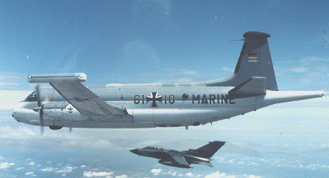
Interest in an improved Atlantique ATL3 has been rekindled following the decision by Germany and Italy to proceed with a competition to replace their earlier Atlantic Mk1s. France remains the sole operator of the Atlantique ATL2.
The ATL3 is largely based on the aircraft offered for the UK's Replacement Maritime Patrol Aircraft competition, which was won by the Nimrod MRA4 in 1996. The ATL3 would be re-engined with R-RAllisonAE2100 turboprops with six-bladed Dowty propellers, replacing the earlier R-R Tynes.
Other changes include a new cockpit, navigation and weapons systems. Sensors will include an SAR/ISAR radar, FLIR, TV and ESM.
The ATL2 first flew in May 1981 and entered service with the French navy in October 1989, and 28 were delivered. The mission system includes the Thomson-CSF Iguane search radar, Sadang acoustic processor, Arar ESM and a Tango FLIR in a chin turret.
France has an outline proposal to update the ATL2 to ATL3.
Falcon
Some air forces operate Falcon business jets for VIP and communications tasks. Specialised maritime surveillance variants of the Falcon have been in service for many years, including the Guardian 2 with Thomson-CSF Varan radar. Dassault has outlined plans for electronic intelligence versions of the Falcon 50, and a maritime patrol variant is in service with the French navy.
EL GAVILAN El Gavilan SA, Carrera 3a No. 56-19, Apartado Aéreo 6781, Santa Fé de Bogota 6781, Colombia; tel: +57 (1) 676 1101; fax: +57 (1) 676 0290
Gavilan 358

Certification of the Gavilan 358 light utility aircraft was accomplished in the middle of last year. The piston-powered aircraft first flew in 1990, with a second prototype flying in 1996. The aircraft is in production.
The launch customer is the Colombian air force, which has purchased 358s for the light utility-transport role. A medevac variant is also on offer.
EMBRAER Embraer, Avenue Brigadeiro Faria Lima 2170, Sao Jose dos Campos 12227-901, Brazil; tel: +55 (12) 345 1000; fax+55 (12) 321 8238; web: www.embraer.com
RJ-145/RJ-135
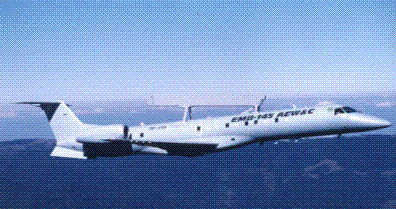
Embraer and Ericsson have teamed to develop and market an AEW version of the ERJ-145 regional jet. The first customer is the Brazilian air force, which has ordered five EMB-145SAs for the SIVAM Amazon surveillance programme.
Greece signed a firm contract for five in the middle of 1999. The first flight of an ERJ-145 equipped with the Erieye phased-array radar - mounted longitudinally above the fuselage - was made early this year. Brazil has ordered a second surveillance variant based on the regional jet platform, the EMB-145RS. It is equipped with an SAR and FLIR, as well as SIGINT and COMINT sensors.
Embraer is also marketing its twoERJ-135/145 regional jets in the VIP/communications market, and is discussing an order with the Brazilian air force.
FAIRCHILD AEROSPACE Fairchild Aerospace, 10823 NE Entrance Road, San Antonio 78260 Texas, USA; tel: +1 (210) 824 9421; fax: +1 (210) 804 7785; web: www.fairchilddornier.com
C-26
Fairchild's Metro twin turboprop regional aircraft is in service with the US Air National Guard, which operates 13 C-26As (Metro IIIs) and 37 C-26Bs (Metro 23s) in a variety of roles. A total of 10 aircraft have been modified to carry an underfuselage surveillance pod.
FORWARD AIRCRAFT Forward Aircraft, Prinsengracht 673, 1017 JT Amsterdam; tel: +31 (20) 620 8981; fax: +31 (20) 620 8926.
Fokker 60
Forward Aircraft is attempting to restart production of the Fokker 60 twin turboprop aircraft. It is targeting the US Common Airborne Sensor programme as a potential launch order for the aircraft, which is a stretch of the Fokker 50.
Four are in service with the Royal Netherlands Air Force. Stork company Fokker Services continues to provide support for Fokker aircraft.
GALAXY AEROSPACE Galaxy Aerospace, PO Box 657, Haslet, Texas 76052, USA: tel +1 (817) 837 3700; fax: +1 (817) 837 3723
Astra SPX
Two IAI Astra SPX business jets, designated C-38As, were delivered to the US Air National Guard last year to replace C-21s (Learjet 35As). The USAF has options on two more aircraft.
GULFSTREAM AEROSPACE Gulfstream Aerospace, PO Box 2206, 500 Gulfstream Road, Savannah 31402-2206 Georgia, USA; tel: +1 (912) 965 3865; fax: +1 (912) 965 3084; telex: 546470, web:www.gulfstreamaircraft.com
Gulfstream IV
Gulfstream continues to supply modified GIVs to the Japan ASDF, which operates the aircraft as the U-4 in the operational support, communications and medevac roles. It has a large cargo door on the starboard side of the fuselage and is similar to the USN/USMCC-20G operational support aircraft, a quick change aircraft capable of carrying up to 26 passengers or urgently needed supplies, such as aircraft spares. The Swedish air force operates two GIVs equipped as SIGINT aircraft, designated Tp102Bs.
Gulfstream V
Two Gulfstream V long-range business jets were delivered to the USAF last year as 12-passenger C-37As, part of a programme to replace Boeing VC-137 VIP aircraft. The USAF has orders for four more. Lockheed Martin and Northrop Grumman, the two losing bidders for the UK's ASTOR programme, had based their bids on the GV.
Gulfstream continues to foresee use of the GV in operational support, intelligence gathering and stand-off surveillance roles.
HARBIN AIRCRAFT Harbin Aircraft Manufacturing, 15 Youxie Street, Pingfang District, Harbin 150066, China. tel: +86 (451) 650 1122; fax: +86 (451) 650 2122; telex: 87082 HAF CN
Y-12
A development of the piston-powered Y-11, the Y-12 twin-turboprop utility aircraft has a 17-seat, unpressurised cabin. The current production aircraft, the Y-12 (IV),is equipped with improved control-surface actuation and landing gear systems. It is available with a choice of Western avionics and is marketed in the West by the Canadian Aerospace Group.
HINDUSTAN AERONAUTICS Hindustan Aeronautics, 15/1 Cubbon Road, PO Box 5150, 560 001 Bangalore, India; tel: +91 (80) 2866 701; fax: +91 (80) 286 7140; telex: 8452266 hal in
Fairchild Dornier 228
Hindustan Aeronautics continues to manufacture Fairchild Aerospace's utility 228 twin turboprop under licence for the Indian armed forces. Orders include 36 maritime patrol aircraft for the coast guard; 27 for the navy; and 25 utility transports for the air force. Some of the navy aircraft are equipped with Racal Super Marac radar and anti-ship missiles.
ILYUSHIN Ilyushin Design Bureau, Leningradsky Prospekt 45G, Moscow 125190, Russia; tel: +7 (095) 943 8509; fax: +7 (095) 212 2132; telex: 411956 SOKOL,
Il-76/78
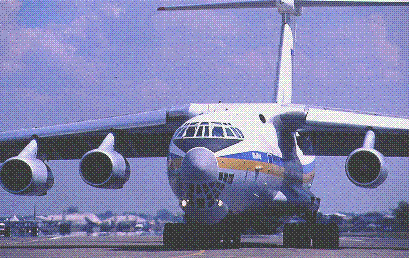
The Il-76 Candid and Il-78 Midas remain the mainstays of the Russian and Ukrainian air forces' transport and tanker fleets.
Financial difficulties have hampered development of a stretched, re-engined freighter, the Il-76MF, but the commander-in-chief of the Russian military air transport force, the VTA, claimed early this year that the type will enter service in 2001.
Meanwhile, the VTA will embark on a life extension programme, although the programme's scope remains unclear. The basic Il-76 has been the basis for airborne command and control platforms, including the A-50 Mainstay (described separately under Beriev), the Adnan AEW aircraft in Iraq and the Il-82 national command post aircraft, two of which have been seen at Zhukovsky flight test centre.
ISRAEL AIRCRAFT INDUSTRIES Israel Aircraft Industries, Ben-Gurion International Airport 70100, Israel; tel: +972 (3) 935 3111; fax: +972 (3) 935 4162; telex: ISRAV-IL-381002
Phalcon
Israel's Elta Electronics has produced an AEW system, known as the Phalcon, built around its EL/M-2075 L-band phased-array radar. One is in service with Chile, on a Boeing 707-based aircraft.
A system based on the Airbus A310 was offered to Australia, and one based on the Boeing 767 to South Korea. Israel is also modifying an Ilyushin Il-76 airframe, in collaboration with Beriev, to meet a Chinese air force AEW requirement.
LOCKHEED MARTIN Lockheed Martin, 6801 Rockledge Drive, Bethesda, Maryland 20817, USA; tel: +1 (301) 897 6121; fax: +1 (301) 897 6822; web: www.lmco.com
C-5 Galaxy
The USAF awarded Lockheed Martin and Honeywell an initial $451 million contract early this year to upgrade and modernise the cockpit of the 126 C-5A/Bs.
The two companies expect to begin flight testing of an upgraded Galaxy by mid-2000, with first deliveries scheduled for mid-2001. Enhancements in the C-5 Avionics Modernisation Programme include a digital all-weather flight control system and six liquid crystal displays. The replacement communications/navigation suite will include GPS satcom and VHF datalink for CNS/ATM compatibility and a traffic alert and collision avoidance system will be integrated into the system.
In addition, the USAF is seeking funding in its FY2000 budget to replace the Galaxy's GETF39-1C turbofans. GE is offering the CF6-80C2, P&W the PW4650 and R-R the RB211-535 and Trent 500. A total of 81 C-5As and 50 C-5Bs was built.
C-130 Hercules
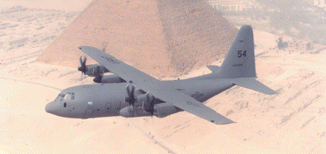
The first operational deliveries of aC-130J, to the UK Royal Air Force and Royal Australian Air Force, are due later this year. Two C-130Js are already at DERA Boscombe Down in the UK being put through their paces for Military Aircraft Release. First RAF squadron deliveries are due by the end of this year. The UK has purchased 25 C-130Js, while the RAAF has order 12 stretched C-130J-30s. Other customers include Italy, with 18, while the US Government has ordered 35 so far, including basic C-130Js for the US Air National Guard, command-post EC-130Js and weather-reconnaissance WC-130Js for the USAF, and KC-130J aerial-refuelling aircraft for the USMC. The USAF has identified a requirement for 168 C-130Js, with procurement to begin in 2002.
The C-130J was proposed but rejected as an AEW&C platform in Australia, fitted with the Lockheed Martin Advanced UHF Radar, although the airframe manufacturer also has agreements to offer the aircraft as a platform for Elta's Phalcon and Ericsson's Erieye phased array radars.
The USAF has launched the $4 billion C-130X Avionics Modernisation Programme to standardise earlier Hercules with a common cockpit and engine. Between 65 and 85 aircraft a year would be modified with a flight management system, INS improvements and GPS receivers. Cockpit changes will include multifunction flat panel displays, dual head-up displays, a new autopilot, terrain warning and collision avoidance systems and CNS/ATM enhancements.
P-3 Orion
Production of the maritime patrol Orion was halted in 1995 after delivery of eight P-3C Update IIIs to South Korea, which still requires another eight aircraft. Lockheed Martin plans to offer Germany and Italy a range of options including the basic P-3C, a re-engined P-3C Plus and the Orion 2000, a re-engined aircraft with a two-crew cockpit, new mission avionics, expanded weapons capability and system improvements.
The USN has structural and avionics upgrade programmes under way to keep its 228-aircraft P-3 fleet viable until it is replaced by the planned Multi Mission Aircraft (MMA). The Sustained Readiness Programme is extending service life, while the Avionics Improvement Programme is installing new anti-surface warfare sensors.
A service life extension is also planned and Lockheed Martin has been awarded a four-year Service Life Assessment Programme to determine the work required to keep the P-3 airworthy until the MMA enters service around 2015. MMA options range from refurbished Orions through remanufactured and new-build P-3s to all-new aircraft designs.
Australia is upgrading the mission systems of 18 AP-3Cs under the Sea Sentinel programme. Raytheon Systems delivered the first upgraded aircraft in September 1998. New Zealand is re-winging six P-3Ks to extend life, and Norway is upgrading the mission systems in four P-3Cs.
The P-3 was first flown in 1958. A total of 649 was built, including 345 P-3Cs. Kawasaki built the P-3 under licence in Japan.
S-3 Viking
Service-life extension and new sensors to improve the aircraft's coastal warfare capabilities will keep the S-3 carrierborne maritime-patrol aircraft operational until 2015, by which time the USN hopes to have the replacement Common Support Aircraft ready.
A total of 187 S-3As was built, and 121 were upgraded to S-3Bs, with improved mission systems. A further 16 S-3As were modified to ES-3A Shadow electronic-warfare/reconnaissance aircraft, but these will be retired by the end of this year.
The USN is preparing its life improvement programme, with measures collectively known as Viking 21 by the manufacturer. A critical area is wing life, and Lockheed Martin started full-scale fatigue testing in May. Changes to the avionics system include new radios, with satcom capabilities, new VHF communications, an INS with embedded GPS, a 1553 databus, liquid crystal displays, digital flight data computer and upgraded open architecture mission computer.
Tests of an S-3 with a Raytheon APS-137B(V)5 radar are due this year. Another aircraft will have a Wescam television/infrared sensor and Link 16 datalink.
Meanwhile, for the international market, Lockheed Martin is pursuing the possibility of taking retired S-3Bs and ES-3s and equipping them with systems from the P-3 Avionics Improvement Programme.
U-2
USAF U-2R reconnaissance aircraft are being re-engined with the GE F118 turbofan, which replaces the P&WJ75 and extends service life to 2020. The upgraded U-2S has increased range, altitude and payload, and improved reliability and maintainability. Meanwhile, Raytheon has started flight tests under the ASARS-2 radar improvement programme, which uses off-the-shelf software to give better real-time precision targeting, broad area synoptic coverage, imagery for measurement of intelligence applications and ground moving target indication.
A multi-processor computer will also be fitted to provide onboard, instead of ground based, processing. ASARS-2 production versions will enter service with the USAF's 35 U-2Ss late next year. AlliedSignal has delivered the first up front control display and panel for laboratory integration testing under the Reliability Avionics Maintainability Programme, which calls for aircraft integration testing to start next February next year, followed by flight validation in the third quarter.
The new avionics suite incorporates two liquid crystal displays, interactive communications and navigation control panel, a revised avionics processor and GPS. The first operational aircraft will be modified in 2001.
LOCKHEED MARTIN ALENIA TACTICAL TRANSPORT SYSTEMS Lockheed Martin, 6801 Rockledge Drive, Bethesda, Maryland 20817, USA; tel: +1 (301) 897 6121; fax: +1 (301) 897 6822; web: www.lmco.com
C-27J Spartan II
The C-27J is being developed as a joint venture between Alenia and Lockheed Martin, using technology and systems from the C-130J to update the G222 twin turboprop. The first aircraft was rolled out of Alenia's Turin factory in June and is scheduled to have its first flight in August. Changes include new Honeywell avionics and R-R Allison AE2100 engines driving Dowty six bladed propellers. Civil certification is planned for the end of next year, with first deliveries by mid-2001. Australia has shortlisted the C-27J for a light-transport requirement of 10 aircraft, and five options, as has Greece, which needs 15.
MYASISCHEV Myasischev Design Bureau, Zhukovski 140160, Moscow Region, Russia; tel: +7 (095) 272 6041; fax: +7 (095) 556 5583
M-17/M-55 Mystic
The M-17 and M-55 are single- and twin-engined high altitude reconnaissance aircraft, respectively, with high aspect-ratio wings and twin-boom tails. Production ceased in 1994 because of a funding drought, but models have continued to appear at international trade shows. Some show versions equipped with side-looking radar, while others carry civilian scientific payloads for atmospheric research. Neither the M-17 nor the M-55 is believed to have entered air force service.
NORTHROP GRUMMAN Northrop Grumman, 1840 Century Park East, Los Angeles 90067-2199, California, USA; tel: +1 (310) 553 6262; fax: +1 (310) 201 3023; web: www.northgrum.com
E-2 Hawkeye
Northrop Grumman won an order for 22 improved E-2C Hawkeye 2000s for the USN and France in mid-1999, which will keep the production line open until 2006. The first will be delivered in October 2001 at an initial rate of four aircraft a year.
The enhanced Hawkeye 2000 incorporates a open architecture mission computer upgrade (MCU), advanced controller indicator set (ACIS) workstations with enlarged displays, co-operative engagement capability (CEC) data distribution system, satellite communications and improved cooling. It is planned to upgrade 54 earlier Group 2 aircraft to Hawkeye 2000s, starting in around 2003-4. Five earlier aircraft have been equipped with MCU and ACIS components for testing throughout this year. CEC trials started in April 1998. The system provides a link between the E-2, other airborne sensors, satellites and shipboard radars.
Infrared systems and electronically scanned radars are potential future E-2 upgrades. The first will provide a passive ballistic missile tracking capability, while the latter will improve the E-2's capabilities against low flying targets in the littoral environment.
E-8 JSTARS
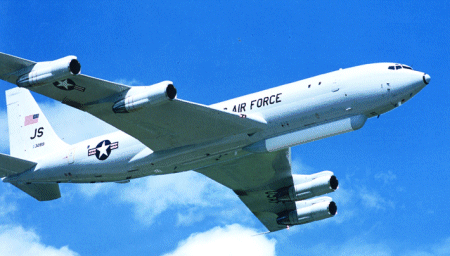
Despite the US DoD's 1997 decision to reduce the USAF's E-8 Joint Surveillance Attack Radar System (JSTARS) requirement from 19 to 13 aircraft, moves are afoot to increase the procurement once again.
Meanwhile, CFM International has proposed re-engining the aircraft - which is based on a refurbished Boeing 707-320C airframe - with CFM56-2s, which would provide commonality with the USAF's KC-135Rtankers and reduce maintenance and operating costs.
The JSTARS achieved initial operational capability with the USAF in December 1997, following delivery of the third production E-8C. Equipped with a Northrop Grumman APY-3 battlefield-surveillance radar, the E-8 was first flown in December 1988. Two E-8A prototypes were built. The radar is essentially an MTI unit, which can also produce SAR images. Under the Radar Technology Insertion Programme, the sensor will be upgraded to simultaneous SAR/MTI capability.
PILATUS Pilatus Aircraft, Flugzeugwerke Stans, CH-6371, Switzerland; tel: +41 (41) 619 6111; fax: +41 (41) 610 3351; telex: 866202; web: www.pilatus-aircraft.com
Pilatus continues to offer a military derivative of its PC-6 Turbo Porter STOL utility aircraft. The company is also offering the PC-12 single-turboprop utility aircraft as the basis of dedicated military variants. The PC-12 Eagle carries a variety of electro-optical sensors in an underfuselage pod.
RAYTHEON AIRCRAFT Raytheon Aircraft, 10511 E Central, PO Box 85, Wichita, 67201-0085, Kansas, USA; tel: +1 (316) 676 8674; fax: +1 (316) 676 5687; web: www.raytheon.com/rac
Beech King Air
Variants of the Beech King Air twin turboprop and Beech 1900 regional airliner have been produced for military use. Aircraft operated by the US services are designated C-12s and include 40 C-12Fs (King Air 200s) for the USAF and six C-12Js (1900Cs) for the US Air National Guard.
Beechjet 400
Delivery to the USAF of 180 T-1A Jayhawk tanker/transport trainers, based on the Beechjet 400A business jet, ended in September 1997. Japan has received nine, designated T-400s.
Hawker 800

Special mission versions of the Hawker 800 business jet include the search and rescue U-125A for the Japan MSDF, which plans to acquire 27. The Japan ASDF operates four U-125 flight-inspection aircraft. The USAF operates six similarly equipped Hawker 800s, as C-29As. South Korea has ordered four Hawker 800XPs with the Raytheon ASARS-1 synthetic-aperture radar, for surveillance.
SAAB Saab Military Aircraft AB, Linköping, SE-581 88, Sweden; tel: +46 (13) 18 00 00; fax: + 46 (13) 18 18 02; telex: 50040 saablg s; web: www.saab.se
Saab 340/2000
The Swedish air force has taken delivery of six 340s equipped with the Ericsson Erieye phased-array surveillance adar. The so-called Argus is used for AEW, feeding its data to ground stations for use by fighter controllers. Saab has also produced a search-and-rescue 340 for the Japan. With the ending of Saab turboprop aircraft production, it is likely that some ex-airline aircraft will be acquired by air forces for conversion to special missions and for use as communications aircraft.
SHAANXI AIRCRAFT Shaanxi Aircraft, PO Box 34, Chengdu, 723213, Shaanxi, China; tel: +86 (916) 216 301; fax: +86 (916) 216 302
Y-8
This Chinese development of the An-12 Cub dates back to the late 1960s, but production examples did not roll through the factory doors until the late 1980s. Transport, electronic countermeasures and maritime reconnaissance versions have been identified although it is questionable whether the type has entered service or been built in large numbers.
SCHWEIZER AIRCRAFT Schweizer Aircraft, PO Box 147, Elmira 14902, New York, USA; tel: +1 (607) 739 3821; fax: +1 (607) 796 2488; telex: 932459; web: www.schweizer-aircraft.com
RU-38 Twin Condor
Development of a twin engined conversion of the Schweizer RG-8A Condor surveillance aircraft continues. One aircraft, with pusher and tractor Teledyne Continental GIO-550 piston engines and twin booms, has been flown.
The US Coast Guard plans to convert two RG-8s to RU-38As, designed for covert, low-level, day/night, patrol missions.
SHIZIAZHUANG AIRCRAFT Shiziazhuang Aircraft, PO Box 164, Shiziazhuang, Hebei 050062, China; tel: +86 (311) 777 5283; fax: +86 (311) 775 2993
Y-5C
Shiziazhuang continues to build versions of the Antonov An-2 Colt biplane. The Chinese People's Liberation Army Air Force ordered 24 in 1996 - probably the Y-5C.
SHINMAYWA Shinmaywa Industries, 5-25 Kosone-cho 1-chome, Nishinomiya 663, Japan; tel: +81 (798) 47 0331; fax: +81 (798) 41 0755
US-1
The JMSDF operates 17 US-1A amphibians in the SAR role. An upgraded variant, the US-1A Kai, is being developed. It will use the R-R Allison AE2100 turboprop and Dowty six-bladed propeller of the Lockheed Martin C-130J and will be fitted with a Kawasaki fly-by-wire system, flat panel cockpit displays, a search radar, pressurised upper hull and composite wing structure. The US-1 modification engineering team is due to complete the first phase of detailed design and static testing by year-end. First flight is due in 2002-3.
XIAN AIRCRAFT Xian Aircraft Company, PO Box 140-84, Xian, 710000 Shaanxi, China; tel: +86 (29) 721 4959; fax: +86 (29) 620 3707
Y-7/Y-7H
Chinese copies of the An-24 were initiated in the mid-1960s, although production Y-7s did not start emerging until the early 1990s. The Y-7H is a copy of the An-26.
Source: Flight International
















